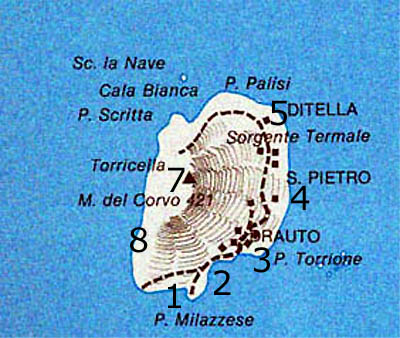 Isola di Panarea (HYCESIA)
Area
3,2 sq. km Abitanti 276
Isola di Panarea (HYCESIA)
Area
3,2 sq. km Abitanti 276
For further information (click on the link hereunder):
The western cliffs hosting a rich
flora of endemic species: the Silene hicesiae, the a
Centaurea aeolica (both exclusive in the archipelago), the
Iberis semperflorens, the Seseli prostrate. In the same
environments nests a colony of falcon of the Queen (Falco
eleonorae). On the small islands (Lisca Bianca,
Bottaro, Dattilo) are living populations of lizard field (Podarcis
sicula) characterized by color more vivid than those of the
greater island, which are the evidence of the principle of
an independent evolutionary path
History
Panarea is the
smallest island in the Aeoliana rchipelago.
Scientist believe that Panarea, reefs and islets
that surround it are the remains of an ancient
volcano submarine, partly submerged by the waters in
the interglacial periods. At the moment in the
emerged part is possible to recognize a single
volcanic layer with numerous secondary eruptive
centers.Of the original volcano remains only the
eastern part because Western has undergone several
collapses which have reduced much of the original
surface. The apparatus volcanic overall it must be
considered the oldest in Aeolian Islands.
It was inhabited from the third millennium BC,
because of its particularly happy and verdant
nature. 23 huts ovals indicate an organized
community. It was found Mycenaean pottery coming
from Egeo, demonstrating the then existing business
relationships. At the tip of Capo Milazzese was
unearthed a prehistoric village from the Bronze Age
(dating back to a period ranging from the fifteenth
to the twelfth century. BC). From the archaeological
point of view is interesting Basiluzzo, where they
were found important evidence of Roman buildings. It
was permanently inhabited until the Roman period,
then the community suffered the problems of the
history Aeolian with the consequent destruction.
From V to VI century. DC, piracy arabo-turca
hindered the further development of the island,
which remained virtually uninhabited. Around the end
of '600, the inhabitants stable produced wheat,
vegetables and fruits that also traded in Lipari.
Because of the barbarian incursions remained with
few inhabitants.
Overland
Tours The small promontory of Capo Milazzese is
located at Cala Junco. From contrada Castello can be
reached Timpone of the Corvo, the highest peak of
the island. Starting from S. Peter northward is
reaching Ditella known for its fumaroles. Near
St. Peter is a beneficial source of thermal hot
water.
Sea Excursions
Among the most important steps there is the trip to
Bay Cala Junco, extreme southern tip of Panarea.
Made the turn of the island we can go to the islands,
to the ancient Roman ruins of Basiluzzo and
Spinazzola. Lisca Bianca, with small fumaroles
submarine, Bottaro, Lisca Bianca and Dattilo shaped
pyramid. To the north of Dattilo they are the five
Panarelli and the Formiche whose water are diving
destination.
Itineraries for divers
The Rock "Petra
Nave". The pitfall of "Petra Nave" is an
important part of the seabed surrounding steep
Panarea. The goal of immersion is a huge mountain of
boulders that the maximum depth of 33 meters, up to
11 on its top for a very considerable extent.
The wreck of Lisca
Bianca Finding the wreck of the freighter sank
english is pretty easy: you need to Panarea route to
the rock of Lisca Bianca and cross the channel
between this and the close of rock Bottaro. Next,
besides the beach, the coast of the little island
change abruptly direction; it is off this slope that
between 30 and 40 meters lies the carcass of the
ship english. The wreck is located 25 meters deep.
TO VISIT:
Prehistoric Village of Cape Milazzese
NOT MISS:
Tour of the island with stops at: Cala
Junco, the cave of Tobacco, fumaroles submarine, cave of
Homer and excursions at little island of Basiluzzo (with the
cave of Coal), Panarelli, Dattilo, Lisca Bianca, Bottaro,
and Lisca nera and Formiche.
TRIPS:
Rocca St. Peter and Gola del Bove, Timpone
of Corvo, the Calcara beach
USEFUL NEWS:

LEGENDA: 1-Cala Junco 2-Punta Milazzese
3-Drauto
4-San Pietro
5-Ditella
6-Calcara
7-Punta del Corvo